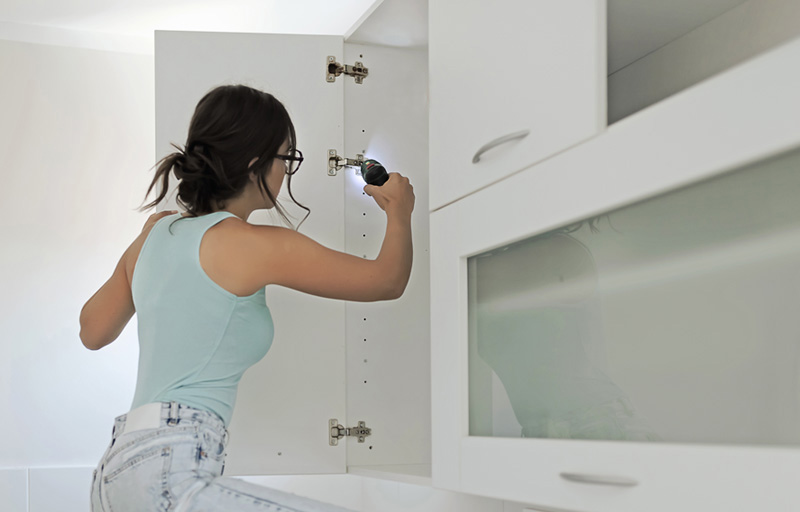Owning a home can be really exciting, but when it comes to home maintenance, sometimes it’s hard to know when to hire a professional versus when to do it yourself.
While hiring a pro is always an option, there are some basic home maintenance tasks that can easily be done on your own. With a few simple instructions (possibly a trip to the local hardware store), you cross these off your list.
Plus, by doing some of your own maintenance you’ll save money and not be dependent on someone else’s timeline.
Here are 10 home maintenance how-to’s that every homeowner should know.
#1. Reset a Breaker
Deciding to play electrician is never a good idea, but when it comes to basic home maintenance you can definitely take care of a tripped breaker on your own.
Sometimes when we run too many things at once, a circuit breaker in your electrical panel will flip off. This is usually obvious as you will experience a sudden loss of power at the outlets.
To reset a breaker, find your electrical panel. Inside, you will see the breaker switches, and if one has been tripped, it will be flipped to the off position.
Make sure anything you had plugged into that breaker is turned off, and then switch the breaker in the panel back into the on position.
#2. Shut Off the Main Water Valve
While nobody expects something like a burst pipe or a large leak to happen, knowing how to handle it when it does will save you from potential headaches.
Every home should have a shut off valve, where the main water line comes into the house. If you don’t know where it is, then it’s time to find out. Start by looking for a round or lever style handle.
In the event you have a water-related emergency, especially one where you can’t tell where the leak is originating, turning off the main water valve will hold off any further damage occurring. From there, you can call a plumber and have them do a full assessment of the situation.
#3. Stop a Running Toilet
Not only is the sound of a toilet running non-stop annoying, but if the toilet overflows things can get messy. Plus, water constantly running in the toilet is simply wasteful, and your water bill will be impacted.
Usually a running toilet is caused by the flapper — the rubber stopper inside the tank — being degraded or damaged.
Start by confirming the flapper is the issue. Take the back off the tank, reach in and press down on the flapper. If this corrects the problem, then the seal of your flapper is no longer effective.
Your next step is to turn off the water to the toilet (the supply valve in at the back, underneath the tank).
Time to hit the hardware store for a new one! We recommend removing the existing flapper and taking it with you to ensure you get the exact right replacement.
Then, it’s time to install. The flapper will come with instructions to follow, but it’s important to note you may need to adjust the chain attached to the flapper to ensure there isn’t too much slack.
Once you’ve completed your install, turn the water valve back on and you should be back in business.
#4. Patch a Hole in the Wall
Holes in the walls of your house are going to happen. Whether you’re changing decor and have holes left behind from artwork or you’re moving furniture and accidentally scratch the wall, it’s inevitable.
Patching small holes is one of the easiest home maintenance tasks to complete, and requires only a few materials.
To patch a hole in your wall you will need quick dry putty, fine grit sandpaper and some paint.
For smaller holes, you simply putty the hole, let it dry, sand it smooth and touch up the paint.
For bigger holes, most hardware stores carry patch kits, which include a few extra materials such as drywall mesh, as well as directions on how to complete a patch.
#5. Unclog a Drain
Most homeowners own a plunger, but if you don’t it definitely needs to be on your list of things to buy.
The first sign something is wrong is usually that the water is taking too long to empty. If this is the case, you can try a few different methods to clear the drain:
1. Plunge it. If you’re plunging one side of a double sink, make sure the other side is plugged with a dish towel or something else in order to ensure you have enough pressure.
2. If plunging doesn’t work, you can try a common DIY method of pouring one cup of baking soda down the drain, followed by one cup of vinegar. Let it sit for at least 30 minutes and then pour boiling water down the drain,
3. If the other two attempts were unsuccessful, you can purchase a drain snake from the hardware store and follow the instructions.
If none of these methods work, it’s time to call the plumber!
#6. Clean the Dishwasher
While having to clean an appliance that normally does the cleaning may seem silly, your dishwasher will last longer and be more efficient with regular maintenance.
Over time, the food particles and grease being cleaned off your dishes will leave a residue. That residue can not only create a smell within the dishwasher, but also affect how clean your dishes will get.
To combat this, cleaning your dishwasher on a monthly basis should be part of your home maintenance. All you need to do is put one cup of vinegar in a glass or a bowl, place it in the upper rack and run one cycle of the dishwasher.
At the same time you do this, don’t forget to clean the trap out. Food caught in the trap can also begin to smell and as it deteriorates it can clog the lines.
#7. Replace the Furnace Filter
When looking at your list of regular home maintenance, replacing the furnace filter should be right near the top. Why? Because a clogged filter can make your whole heating system far less efficient.
When your furnace is clogged with dust and dirt has to work that much harder, which in turn can push up your heating and cooling costs. Also, It can impact the longevity of your entire system.
To replace your furnace filter, start by confirming what size of filter you need. Most are a standard size, but if you aren’t sure, pull out the existing filter and the size will be written on the side. If you’re unsure where the filter is in your actual furnace, that should be labelled too.
From there, simply pull out the old one, put in the new one, and then set a reminder for yourself to replace it at the appropriate time in the future.
#8. Fix Squeaky Hinges or Sticky Drawers
Nothing grates on your nerves quite like a drawer that sticks every time you try and pull it out or a door that squeaks like you’re in a horror movie. Luckily, fixing these are two of the easiest home maintenance tasks you can ever do. .
To deal with squeaky drawers, all you need is a piece of candle or paraffin wax or even a bar of soap. Simply drag the soap along the sides or the bottom of the drawer, dust off any loose pieces off the drawer and you should be good to go.
Bar soap can also be used for squeaky doors, but we suggest WD-40, which is available at any hardware store. Simply spray, let it sit, wipe off any excess and your squeaky door should be silenced.
#9. Caulk a Sink or Shower
If you don’t already know, caulking is that rubbery stuff around your tubs, sinks, toilets and faucets. It creates a waterproof seal and protects the floors and walls from any moisture damage.
Over time, caulking can deteriorate or become discolored, and that can result in moisture damage or even mold.
The most important step when repairing the caulk is ensuring you’ve fully removed the old caulk before the new caulk goes on. If this step isn’t done, you will likely have problems with adhesion.
Once you’ve removed all the caulk and cleaned the area, you can begin adding new caulk. Caulking comes in tubes, so the trickiest part of caulking is usually trying to keep your lines straight.
Start by cutting the tip of the caulking tube on an angle, with a smaller hole. The last thing you want is for the hole to be too big, so cut it smaller as you begin to ensure you don’t end up with a useless tube that has a giant hole.
#10. Stop a Leaky Faucet
Did you know that one of the biggest sources of waste inside a residential home is water? And like we touched on earlier, wasted water means wasted money.
Compression type faucets are most common and they’re relatively easy to replace. Many manufacturers have extensive information on their websites that troubleshoot issues, and offer replacement parts, so if your faucet is leaking this is a great place to start.
Handling Your Home Maintenance
While many of the home maintenance tasks we’ve shared are going to be handled on an as-needed basis, some others, like replacing furnace filters, should be performed on a set schedule like once a month or quarter.
As you embark on these new home maintenance tasks, don’t hesitate to assess your comfort level as needed. If you aren’t sure you can do it, the internet will have all the info you may need. From there, you may be surprised at just how accomplished you feel handling these tasks all on your own.
Westcott Homes offers modern living and smart design for today’s active families, in neighborhoods with room to grow. Our flexible floorplans, durable Pacific Northwest exteriors and luxurious interior details add up to a home you’ll delight in every day, and for years to come.







